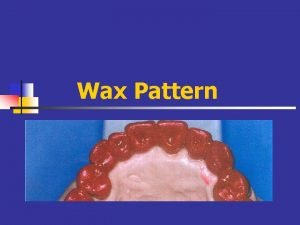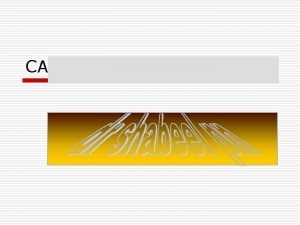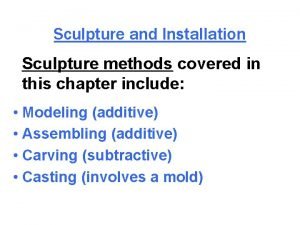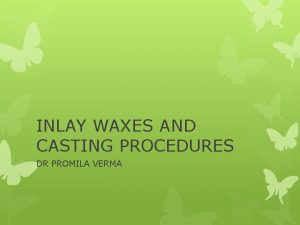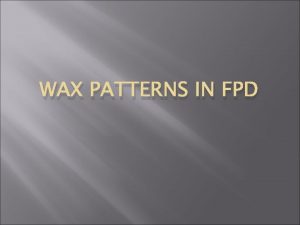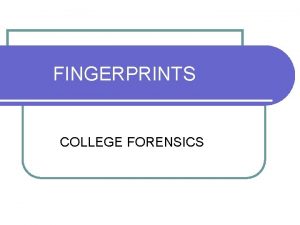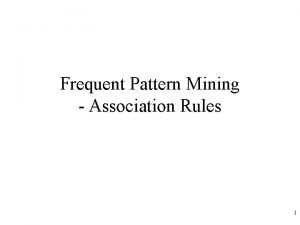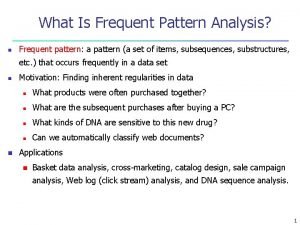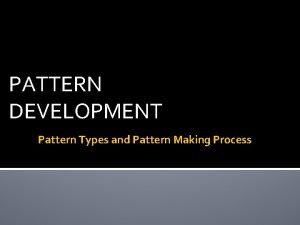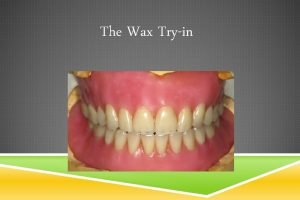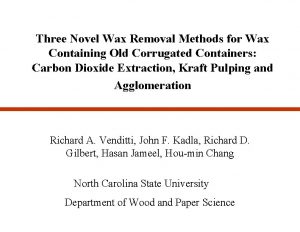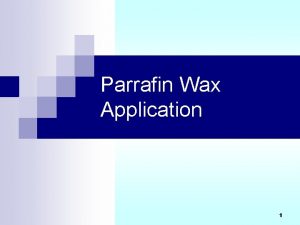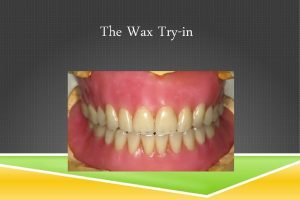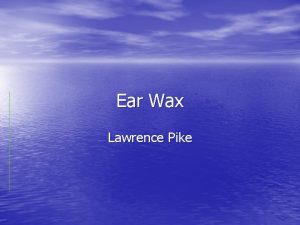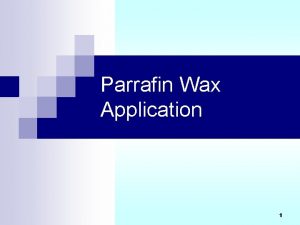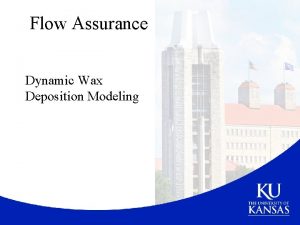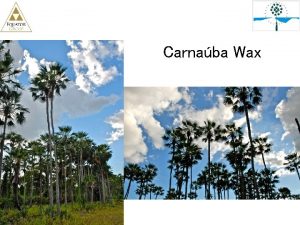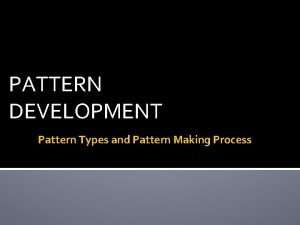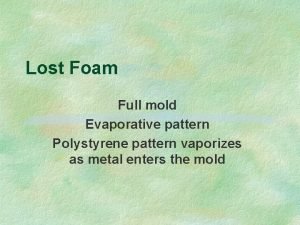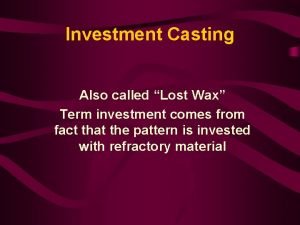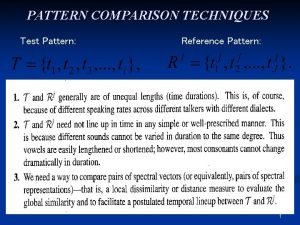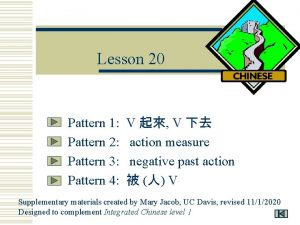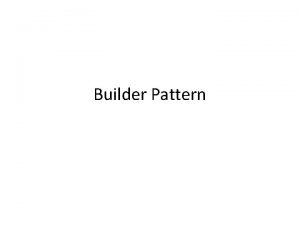Wax Pattern The Lost wax process From the



























































- Slides: 59

Wax Pattern

The Lost wax process - From the wax pattern, the finished cast restoration is duplicated by using the lost-wax process as part of the indirect procedure.

The Lost wax process consists of: a) Obtaining an accurate impression of the prepared tooth.

b) Making a cast from the impression.

c) A wax pattern that resembles the shape of the final restoration is shaped and fabricated on a die.

d) A mold is made around the wax pattern with a refractory investment material. e) When the investment has set, the wax is vaporized in an electric furnace.

f) The hollow mold is then filled with molten casting alloy, reproducing every detail of the wax pattern.

g) The metal casting is recovered, excess metal is removed, and polishing is done. h) The cast restoration is ready for clinical evaluation.












Preparation of the die prior to wax pattern construction

Preparation of the die prior to wax pattern construction

Application of the die spacer Ditch The finish line is highlighted by red color pencil

Lubrication of the die with a water soluble lubricant

Ideal requirements of the used wax 1 - It should Flow freely. 2 - It should have a different color than the used die material. 3 - It can be carved without flaking. 4 - It can accept addition. 5 - It can attain fine details till investing without distortion

Ideal requirements of the used wax 6 - It should have a minimum rate of stress relaxation to prevent distortion before investing and casting. 7 - It can be burnished and polished. 8 - It should have an acceptable strength after cooling. 9 - It should evaporate without leaving any debris that can contaminate the final restoration 10 - It should compensate for the metal shrinkage.

Composition of inlay casting wax n n 1 - Paraffin wax (40 -60 %) 2 - Dammar resin: reduces flaking 3 - Carnauba or bees wax : raise the melting temp. 4 - Dyes: to provide color contrast

Types of Inlay wax: (according to ADA) n Type I: Soft wax ● used to increase the adaptation to the die walls.

Types of Inlay wax: (according to ADA) n Type II: medium hardness wax ● used to obtain an accurate shape with enough strength to resist deformation of the wax pattern and to hold the produced details till the casting procedures start.


Methods of fabrication of the wax pattern Dipping method: - It is done by dipping the die into wax that was melted using the wax dipping pot. - It helps to form a uniform, thin, and adapted layer of wax on the die. n

Methods of fabrication of the wax pattern n - Addition method: - It is done by melting the wax and dropping it using a wax heated carver. - A bulk of wax is formed and then carved using a sharp carver. - The multiple addition of wax may lead to strain development in the wax mass that tend to be released with time and subsequently distort the wax pattern.

Methods of fabrication of the wax pattern n Molten press method: - It is the best method to construct a wax pattern as it produces accurate and adapted wax patterns. - Molten wax is added and finger pressure is applied on each increment. This insures accurate adaptation between the wax layers and that the wax pattern is free from any irregularities that can cause leaking restorations.

Methods of fabrication of the wax pattern n Molten press method: - Wax application is made using electric waxing instrument to control the temperature during wax pattern construction and produce burnishing effect at the same time with the attached blunt instrument. - Carving is then done using sharp carvers.

Methods of fabrication of the wax pattern n Injection method: - It is done by injecting the molten wax through heated metallic syringes into enclosed mold. - wax feeding continues until hardening of the wax. - This method is used in researches only.

Criteria of the wax pattern for a posterior tooth n 1 -proximal surfaces: - The axial walls cervical to the finish line should be flat or concave to accommodate the interdental papilla.

Criteria of the wax pattern for a posterior tooth n - - 1 -proximal surfaces: - The contact area should be located more buccally and occlusally to allow for a wide lingual embrasure. - Between the first and second molars the contact area is placed centrally.

Criteria of the wax pattern for a posterior tooth n 1 -proximal surfaces: - To ensure that the axial wall has enough thickness, and the contact area exhibit slight pressure on adjacent natural teeth, small amount of stone is carved from proximal wall on adjacent teeth on both the mesial and distal sides on the cast.

Criteria of the wax pattern for a posterior tooth n - - 1 -proximal surfaces: - Too wide contact area will prevent food deflection. - Too narrow contact area will allow fibrous food to wedge between natural teeth.

Criteria of the wax pattern for a posterior tooth 2 -Buccal and lingual surfaces: n - The contour of the buccal and lingual surfaces of the wax pattern should be in accordance with that of the adjacent teeth.

Criteria of the wax pattern for a posterior tooth 2 -Buccal and lingual surfaces: n - The height of contour is located at the cervical 1/3 except for the lingual surface of the mandibular teeth; the height of contour is located at the middle 1/3.

Criteria of the wax pattern for a posterior tooth 2 -Buccal and lingual surfaces: n - The surface of the tooth extending from the base of the gingival sulcus till the height of contour (Emergence profile) should be straight to facilitate cleaning by the brush.

Criteria of the wax pattern for a posterior tooth 2 -Buccal and lingual surfaces: n - Overcontouring promotes accumulation of food debris and plaque that produces gingival inflammation and hyperplasic changes of the gingival. n - Undercontouring allows forced food deflection on the gingival that may lead to gingival recession.

Criteria of the wax pattern for a posterior tooth n n 3 -Occlusal surface morphology: - Cusps are either functional or non functional. - Functional cusps are the buccal cusps of the mandibular teeth and the palatal cusps of maxillary teeth.

Criteria of the wax pattern for a posterior tooth n n 3 -Occlusal surface morphology: - During centric occlusion functional cusps contact the opposing tooth surface (occlusal fossae and marginal ridges) and act as a mortar for grinding food. While, non functional cusps act as the rim of the mortar to prevent food overflowing, and to protect the buccal mucosa and the tongue during chewing.

Criteria of the wax pattern for a posterior tooth n n n 3 -Occlusal surface morphology: - The occlual scheme may be cusp- fossa or cusp-marginal ridge relationship. When the teeth relationship allows the cuspfossa scheme is considered optimal.

Criteria of the wax pattern for a posterior tooth n n 3 -Occlusal surface morphology: - The occlusal surface contains two types of grooves: primary groove that represent the union between the lobes, and secondary grooves which are shallower. Secondary groves are located at the inclined planes of the cup and produce narrow ridges (accessory ridges), that increase the cutting efficiency during mastication.

Criteria of the wax pattern for a posterior tooth - - Wax pattern construction of the occlusal surface : a- Cone placement.

Criteria of the wax pattern for a posterior tooth - - Wax pattern construction of the occlusal surface : b- Superimposition of cuspal ridges.

Criteria of the wax pattern for a posterior tooth - - Wax pattern construction of the occlusal surface : c- Waxing of triangular ridges.

Criteria of the wax pattern for a posterior tooth - - Wax pattern construction of the occlusal surface : d- Waxing of secondary and marginal ridges.

Criteria of the wax pattern for a posterior tooth - - Wax pattern construction of the occlusal surface : e- Complete occlusal morphology.

Criteria of the wax pattern for a posterior tooth n n n 4 -Cervical margin: - The margin must be reflowed immediately before investing of the pattern, this helps to maximize the adaptation of the wax pattern to the die. - This technique has two advantages: a-Minimizes dissolution of the luting agent. b-Facilitates plaque control.

Criteria of the wax pattern for a posterior tooth n n n 4 -Cervical margin: - If the margins are overextended: it will prevent seating of the restoration on the tooth and can cause gingival inflammation. - If the margins are underextended: the finished restoration will not produce adequate seal.

Criteria of the wax pattern for a posterior tooth n n 4 -Cervical margin: - If the margins are rough: will act as a site for plaque accumulation that can lead to gingival inflammation.

Criteria of the wax pattern for a posterior tooth n n n 5 -Finishing and polishing of the wax pattern: -Finishing of the wax pattern using a piece of a silk cloth that is wet with water and a detergent can cause smoothening of the pattern and remove any cracks. - It also helps to burnish the pattern and improves its adaptation to the die.

Criteria of the wax pattern for a posterior tooth n n 5 -Finishing and polishing of the wax pattern: - The pattern is removed from the die to be using a small piece of rubber dam with light catching by the thumb and the forefinger of one hand.

Criteria of the wax pattern for a posterior tooth n n 5 -Finishing and polishing of the wax pattern: - Any defect in the wax pattern should be corrected, because correcting the defect in the wax is much easier than after casting.

Evaluation of occlusion: : A, Anteroposterior curve (curve of spee). B, compansating curve (curve of Wilson).

Thank you Thanks for listening
 Lost sheep lost coin lost son
Lost sheep lost coin lost son Molten press method of wax pattern
Molten press method of wax pattern Lost wax pattern technique
Lost wax pattern technique Lost wax process supplier
Lost wax process supplier The additive process of sculpture includes:
The additive process of sculpture includes: Sprue wax composition
Sprue wax composition Indirect wax pattern
Indirect wax pattern Inlay wax pattern fabrication
Inlay wax pattern fabrication Horizontal finishing line
Horizontal finishing line Afis fingerprint
Afis fingerprint Pattern and pattern classes in image processing
Pattern and pattern classes in image processing Max pattern and closed pattern
Max pattern and closed pattern Frequent pattern
Frequent pattern Hát kết hợp bộ gõ cơ thể
Hát kết hợp bộ gõ cơ thể Lp html
Lp html Bổ thể
Bổ thể Tỉ lệ cơ thể trẻ em
Tỉ lệ cơ thể trẻ em Voi kéo gỗ như thế nào
Voi kéo gỗ như thế nào Chụp phim tư thế worms-breton
Chụp phim tư thế worms-breton Bài hát chúa yêu trần thế alleluia
Bài hát chúa yêu trần thế alleluia Các môn thể thao bắt đầu bằng tiếng nhảy
Các môn thể thao bắt đầu bằng tiếng nhảy Thế nào là hệ số cao nhất
Thế nào là hệ số cao nhất Các châu lục và đại dương trên thế giới
Các châu lục và đại dương trên thế giới Cong thức tính động năng
Cong thức tính động năng Trời xanh đây là của chúng ta thể thơ
Trời xanh đây là của chúng ta thể thơ Mật thư anh em như thể tay chân
Mật thư anh em như thể tay chân Phép trừ bù
Phép trừ bù Phản ứng thế ankan
Phản ứng thế ankan Các châu lục và đại dương trên thế giới
Các châu lục và đại dương trên thế giới Thơ thất ngôn tứ tuyệt đường luật
Thơ thất ngôn tứ tuyệt đường luật Quá trình desamine hóa có thể tạo ra
Quá trình desamine hóa có thể tạo ra Một số thể thơ truyền thống
Một số thể thơ truyền thống Cái miệng nó xinh thế chỉ nói điều hay thôi
Cái miệng nó xinh thế chỉ nói điều hay thôi Vẽ hình chiếu vuông góc của vật thể sau
Vẽ hình chiếu vuông góc của vật thể sau Nguyên nhân của sự mỏi cơ sinh 8
Nguyên nhân của sự mỏi cơ sinh 8 đặc điểm cơ thể của người tối cổ
đặc điểm cơ thể của người tối cổ Thế nào là giọng cùng tên? *
Thế nào là giọng cùng tên? * Vẽ hình chiếu đứng bằng cạnh của vật thể
Vẽ hình chiếu đứng bằng cạnh của vật thể Vẽ hình chiếu vuông góc của vật thể sau
Vẽ hình chiếu vuông góc của vật thể sau Thẻ vin
Thẻ vin đại từ thay thế
đại từ thay thế điện thế nghỉ
điện thế nghỉ Tư thế ngồi viết
Tư thế ngồi viết Diễn thế sinh thái là
Diễn thế sinh thái là Các loại đột biến cấu trúc nhiễm sắc thể
Các loại đột biến cấu trúc nhiễm sắc thể Các số nguyên tố là gì
Các số nguyên tố là gì Tư thế ngồi viết
Tư thế ngồi viết Lời thề hippocrates
Lời thề hippocrates Thiếu nhi thế giới liên hoan
Thiếu nhi thế giới liên hoan ưu thế lai là gì
ưu thế lai là gì Hổ sinh sản vào mùa nào
Hổ sinh sản vào mùa nào Sự nuôi và dạy con của hươu
Sự nuôi và dạy con của hươu Sơ đồ cơ thể người
Sơ đồ cơ thể người Từ ngữ thể hiện lòng nhân hậu
Từ ngữ thể hiện lòng nhân hậu Thế nào là mạng điện lắp đặt kiểu nổi
Thế nào là mạng điện lắp đặt kiểu nổi Definition pattern of development
Definition pattern of development What are the different kinds of patterns of development
What are the different kinds of patterns of development Classification of casting
Classification of casting Two types of pattern development
Two types of pattern development Coronoid process and coracoid process
Coronoid process and coracoid process

